Analysis of Key Issues Impacting Financial Stability in Banks
VerifiedAdded on 2021/02/20
|11
|3856
|147
Report
AI Summary
This report delves into the multifaceted issues surrounding financial stability, focusing on the impact of low interest rates on bank performance and the competitive threats posed by Fintech and Big Tech companies. The report analyzes both the positive and negative effects of low interest rates, including their influence on loan demand, bank profitability, and the ability of banks to maintain financial stability. It also examines the challenges faced by banking intermediaries due to the rise of Fintech and Big Tech, such as the introduction of bank-like services, the utilization of established customer networks, and the provision of services by third parties. The report highlights the implications of these competitive pressures on financial stability, emphasizing the need for banks to adapt and innovate to maintain their market position. The analysis covers the importance of financial stability for economic progress and the ability of banks to finance profitable projects, providing a comprehensive overview of the current challenges and opportunities in the financial sector.
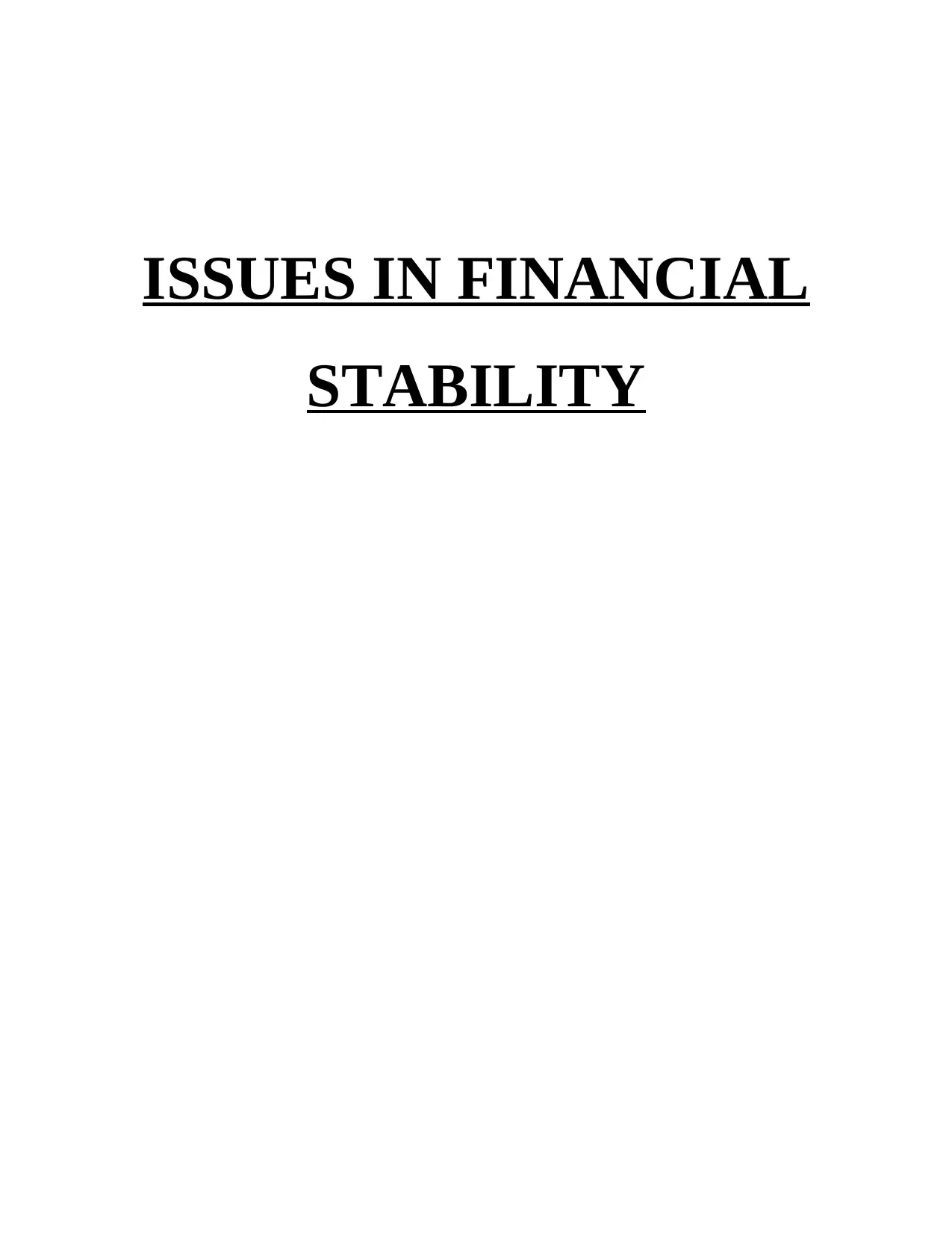
ISSUES IN FINANCIAL
STABILITY
STABILITY
Paraphrase This Document
Need a fresh take? Get an instant paraphrase of this document with our AI Paraphraser
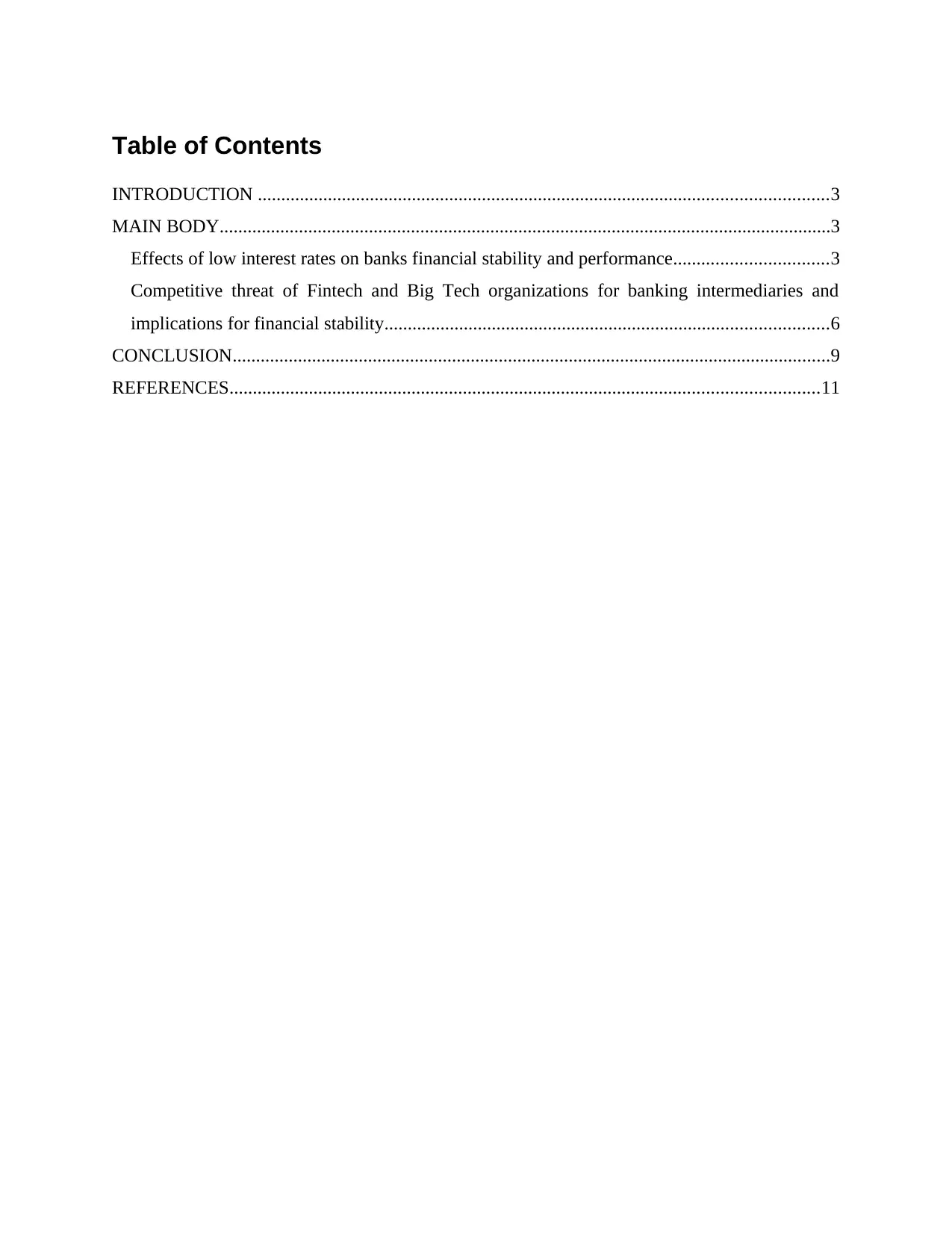
Table of Contents
INTRODUCTION ..........................................................................................................................3
MAIN BODY...................................................................................................................................3
Effects of low interest rates on banks financial stability and performance.................................3
Competitive threat of Fintech and Big Tech organizations for banking intermediaries and
implications for financial stability...............................................................................................6
CONCLUSION................................................................................................................................9
REFERENCES..............................................................................................................................11
INTRODUCTION ..........................................................................................................................3
MAIN BODY...................................................................................................................................3
Effects of low interest rates on banks financial stability and performance.................................3
Competitive threat of Fintech and Big Tech organizations for banking intermediaries and
implications for financial stability...............................................................................................6
CONCLUSION................................................................................................................................9
REFERENCES..............................................................................................................................11
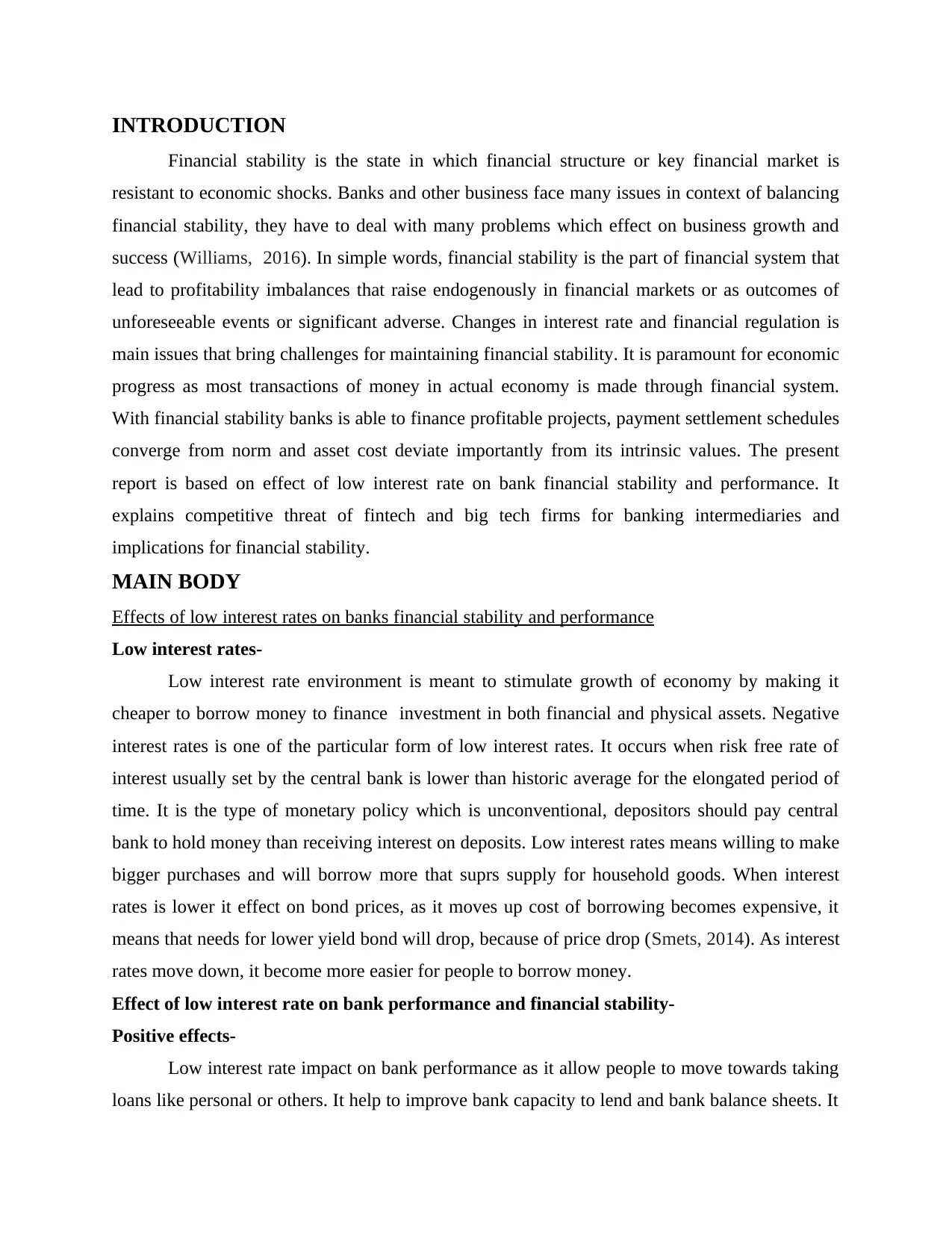
INTRODUCTION
Financial stability is the state in which financial structure or key financial market is
resistant to economic shocks. Banks and other business face many issues in context of balancing
financial stability, they have to deal with many problems which effect on business growth and
success (Williams, 2016). In simple words, financial stability is the part of financial system that
lead to profitability imbalances that raise endogenously in financial markets or as outcomes of
unforeseeable events or significant adverse. Changes in interest rate and financial regulation is
main issues that bring challenges for maintaining financial stability. It is paramount for economic
progress as most transactions of money in actual economy is made through financial system.
With financial stability banks is able to finance profitable projects, payment settlement schedules
converge from norm and asset cost deviate importantly from its intrinsic values. The present
report is based on effect of low interest rate on bank financial stability and performance. It
explains competitive threat of fintech and big tech firms for banking intermediaries and
implications for financial stability.
MAIN BODY
Effects of low interest rates on banks financial stability and performance
Low interest rates-
Low interest rate environment is meant to stimulate growth of economy by making it
cheaper to borrow money to finance investment in both financial and physical assets. Negative
interest rates is one of the particular form of low interest rates. It occurs when risk free rate of
interest usually set by the central bank is lower than historic average for the elongated period of
time. It is the type of monetary policy which is unconventional, depositors should pay central
bank to hold money than receiving interest on deposits. Low interest rates means willing to make
bigger purchases and will borrow more that suprs supply for household goods. When interest
rates is lower it effect on bond prices, as it moves up cost of borrowing becomes expensive, it
means that needs for lower yield bond will drop, because of price drop (Smets, 2014). As interest
rates move down, it become more easier for people to borrow money.
Effect of low interest rate on bank performance and financial stability-
Positive effects-
Low interest rate impact on bank performance as it allow people to move towards taking
loans like personal or others. It help to improve bank capacity to lend and bank balance sheets. It
Financial stability is the state in which financial structure or key financial market is
resistant to economic shocks. Banks and other business face many issues in context of balancing
financial stability, they have to deal with many problems which effect on business growth and
success (Williams, 2016). In simple words, financial stability is the part of financial system that
lead to profitability imbalances that raise endogenously in financial markets or as outcomes of
unforeseeable events or significant adverse. Changes in interest rate and financial regulation is
main issues that bring challenges for maintaining financial stability. It is paramount for economic
progress as most transactions of money in actual economy is made through financial system.
With financial stability banks is able to finance profitable projects, payment settlement schedules
converge from norm and asset cost deviate importantly from its intrinsic values. The present
report is based on effect of low interest rate on bank financial stability and performance. It
explains competitive threat of fintech and big tech firms for banking intermediaries and
implications for financial stability.
MAIN BODY
Effects of low interest rates on banks financial stability and performance
Low interest rates-
Low interest rate environment is meant to stimulate growth of economy by making it
cheaper to borrow money to finance investment in both financial and physical assets. Negative
interest rates is one of the particular form of low interest rates. It occurs when risk free rate of
interest usually set by the central bank is lower than historic average for the elongated period of
time. It is the type of monetary policy which is unconventional, depositors should pay central
bank to hold money than receiving interest on deposits. Low interest rates means willing to make
bigger purchases and will borrow more that suprs supply for household goods. When interest
rates is lower it effect on bond prices, as it moves up cost of borrowing becomes expensive, it
means that needs for lower yield bond will drop, because of price drop (Smets, 2014). As interest
rates move down, it become more easier for people to borrow money.
Effect of low interest rate on bank performance and financial stability-
Positive effects-
Low interest rate impact on bank performance as it allow people to move towards taking
loans like personal or others. It help to improve bank capacity to lend and bank balance sheets. It
⊘ This is a preview!⊘
Do you want full access?
Subscribe today to unlock all pages.

Trusted by 1+ million students worldwide

provide positive affect upon banks performance and attract peoples towards them. Low interest
rate system is beneficial for banks as well as help to raise their performance. Because of low
interest rate banks grab the attention of peoples and provide opportunities who wants low interest
rate loans for different purpose, it increase customer base. It help to improve quality of services
and to offer the pleasant experience to customers. Interest rates stability typically effect with
financial performance of commercial banks. Low interest rates lead to high demand for loans,
people wants to take loans for improving their financial and personal crisis. It effect on banks
balance sheets and increase their performance more than before, strong customers based because
of lower interest rate on loans build positive image of bank within market place which attract
more customers towards them. Low interest rates play significant role for increasing bank
performance and keep its financial stability. It considerably effect purchasing power of peoples,
customers drive towards low interest rates loans for some specific purpose in which they have to
pay interest to banks. Lower interest rates allow consumers to pay money easily for taking loan
as they cannot be able to have to pay higher interest rate to banks (Afonso, Baxa and Slavík,
2018). With the help of lower interest rate banks can be able to build their positive image in
market and retain customers with the for longer term period. Low interest rates make peoples
able to borrow money from banks and pay easily which increase financial performance of bank
effectively. It give opportunity to customers to start up their business and easily pay interest rate
to banks. During financial crisis, several banks specially largest bank in UK like Bank of
England were found to have too little capital, which constricted its ability to make loans during
initial level of recovery. By keeping short term interest rates lower, banks support recapitalize
banking system by helping to raise banking industry net interest margin which boots their
retained earnings. Low interest rates drive customers and provide benefits to pay interest rate at
lower cost as it is beneficial for banks, they can retain peoples with them and gain its trust
effectively. Lower interest rate increase demands for loans and make people capable to pay off
its loans easily. As it contribute to gain trust and build strong relationship between commercial
banks and customers. Low interest rate is one of the main reason behind increasing bank
profitability, losses in business and financial crisis lower interest rates help to overcome issues
and adversely affect banks that positioned itself for continued low rates (Dagher, 2016). Banks
benefits from low interest rates as they can raise assets prices, when banks maximize money
supply, people finds themselves with more money balances than it needs to hole. In response,
rate system is beneficial for banks as well as help to raise their performance. Because of low
interest rate banks grab the attention of peoples and provide opportunities who wants low interest
rate loans for different purpose, it increase customer base. It help to improve quality of services
and to offer the pleasant experience to customers. Interest rates stability typically effect with
financial performance of commercial banks. Low interest rates lead to high demand for loans,
people wants to take loans for improving their financial and personal crisis. It effect on banks
balance sheets and increase their performance more than before, strong customers based because
of lower interest rate on loans build positive image of bank within market place which attract
more customers towards them. Low interest rates play significant role for increasing bank
performance and keep its financial stability. It considerably effect purchasing power of peoples,
customers drive towards low interest rates loans for some specific purpose in which they have to
pay interest to banks. Lower interest rates allow consumers to pay money easily for taking loan
as they cannot be able to have to pay higher interest rate to banks (Afonso, Baxa and Slavík,
2018). With the help of lower interest rate banks can be able to build their positive image in
market and retain customers with the for longer term period. Low interest rates make peoples
able to borrow money from banks and pay easily which increase financial performance of bank
effectively. It give opportunity to customers to start up their business and easily pay interest rate
to banks. During financial crisis, several banks specially largest bank in UK like Bank of
England were found to have too little capital, which constricted its ability to make loans during
initial level of recovery. By keeping short term interest rates lower, banks support recapitalize
banking system by helping to raise banking industry net interest margin which boots their
retained earnings. Low interest rates drive customers and provide benefits to pay interest rate at
lower cost as it is beneficial for banks, they can retain peoples with them and gain its trust
effectively. Lower interest rate increase demands for loans and make people capable to pay off
its loans easily. As it contribute to gain trust and build strong relationship between commercial
banks and customers. Low interest rate is one of the main reason behind increasing bank
profitability, losses in business and financial crisis lower interest rates help to overcome issues
and adversely affect banks that positioned itself for continued low rates (Dagher, 2016). Banks
benefits from low interest rates as they can raise assets prices, when banks maximize money
supply, people finds themselves with more money balances than it needs to hole. In response,
Paraphrase This Document
Need a fresh take? Get an instant paraphrase of this document with our AI Paraphraser
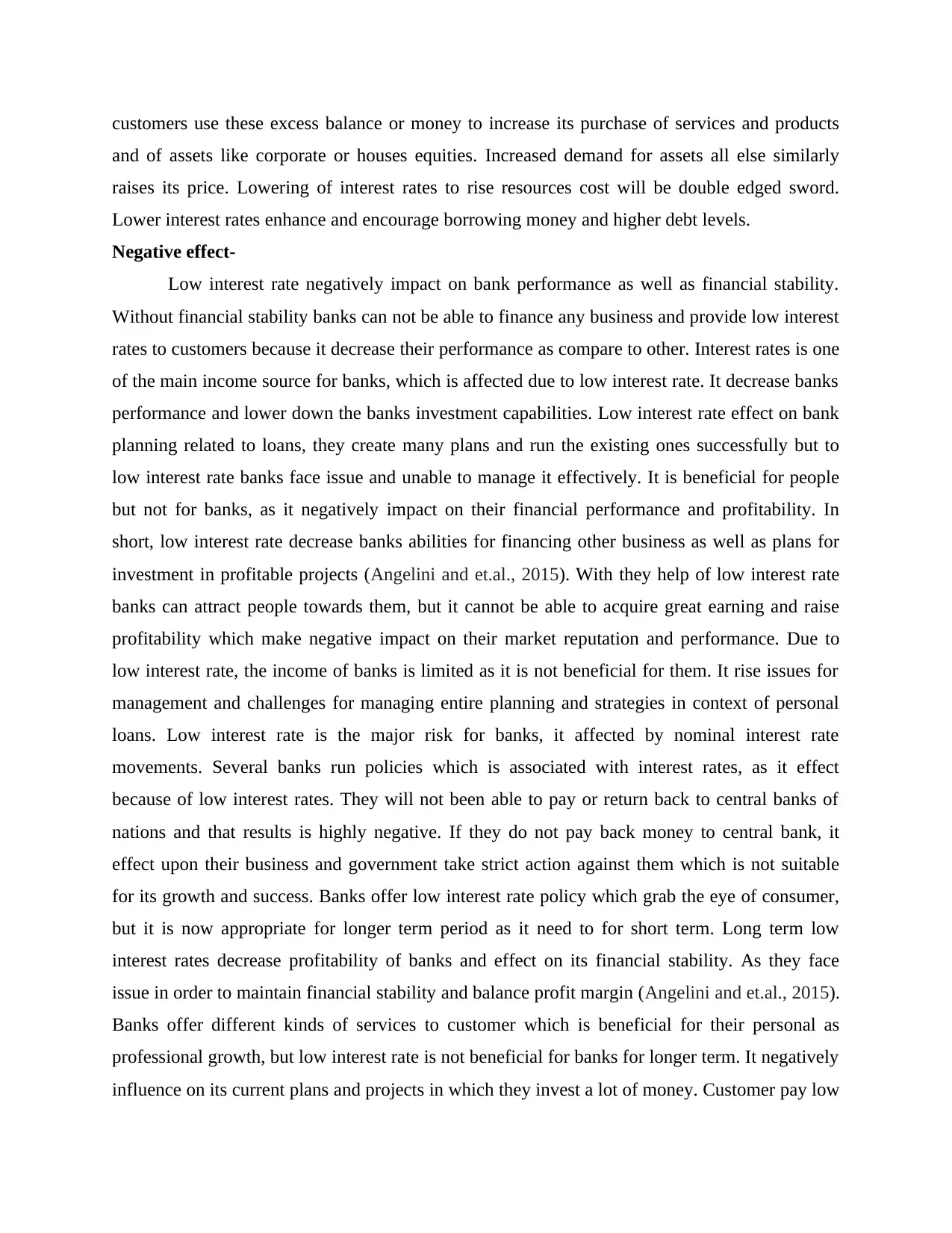
customers use these excess balance or money to increase its purchase of services and products
and of assets like corporate or houses equities. Increased demand for assets all else similarly
raises its price. Lowering of interest rates to rise resources cost will be double edged sword.
Lower interest rates enhance and encourage borrowing money and higher debt levels.
Negative effect-
Low interest rate negatively impact on bank performance as well as financial stability.
Without financial stability banks can not be able to finance any business and provide low interest
rates to customers because it decrease their performance as compare to other. Interest rates is one
of the main income source for banks, which is affected due to low interest rate. It decrease banks
performance and lower down the banks investment capabilities. Low interest rate effect on bank
planning related to loans, they create many plans and run the existing ones successfully but to
low interest rate banks face issue and unable to manage it effectively. It is beneficial for people
but not for banks, as it negatively impact on their financial performance and profitability. In
short, low interest rate decrease banks abilities for financing other business as well as plans for
investment in profitable projects (Angelini and et.al., 2015). With they help of low interest rate
banks can attract people towards them, but it cannot be able to acquire great earning and raise
profitability which make negative impact on their market reputation and performance. Due to
low interest rate, the income of banks is limited as it is not beneficial for them. It rise issues for
management and challenges for managing entire planning and strategies in context of personal
loans. Low interest rate is the major risk for banks, it affected by nominal interest rate
movements. Several banks run policies which is associated with interest rates, as it effect
because of low interest rates. They will not been able to pay or return back to central banks of
nations and that results is highly negative. If they do not pay back money to central bank, it
effect upon their business and government take strict action against them which is not suitable
for its growth and success. Banks offer low interest rate policy which grab the eye of consumer,
but it is now appropriate for longer term period as it need to for short term. Long term low
interest rates decrease profitability of banks and effect on its financial stability. As they face
issue in order to maintain financial stability and balance profit margin (Angelini and et.al., 2015).
Banks offer different kinds of services to customer which is beneficial for their personal as
professional growth, but low interest rate is not beneficial for banks for longer term. It negatively
influence on its current plans and projects in which they invest a lot of money. Customer pay low
and of assets like corporate or houses equities. Increased demand for assets all else similarly
raises its price. Lowering of interest rates to rise resources cost will be double edged sword.
Lower interest rates enhance and encourage borrowing money and higher debt levels.
Negative effect-
Low interest rate negatively impact on bank performance as well as financial stability.
Without financial stability banks can not be able to finance any business and provide low interest
rates to customers because it decrease their performance as compare to other. Interest rates is one
of the main income source for banks, which is affected due to low interest rate. It decrease banks
performance and lower down the banks investment capabilities. Low interest rate effect on bank
planning related to loans, they create many plans and run the existing ones successfully but to
low interest rate banks face issue and unable to manage it effectively. It is beneficial for people
but not for banks, as it negatively impact on their financial performance and profitability. In
short, low interest rate decrease banks abilities for financing other business as well as plans for
investment in profitable projects (Angelini and et.al., 2015). With they help of low interest rate
banks can attract people towards them, but it cannot be able to acquire great earning and raise
profitability which make negative impact on their market reputation and performance. Due to
low interest rate, the income of banks is limited as it is not beneficial for them. It rise issues for
management and challenges for managing entire planning and strategies in context of personal
loans. Low interest rate is the major risk for banks, it affected by nominal interest rate
movements. Several banks run policies which is associated with interest rates, as it effect
because of low interest rates. They will not been able to pay or return back to central banks of
nations and that results is highly negative. If they do not pay back money to central bank, it
effect upon their business and government take strict action against them which is not suitable
for its growth and success. Banks offer low interest rate policy which grab the eye of consumer,
but it is now appropriate for longer term period as it need to for short term. Long term low
interest rates decrease profitability of banks and effect on its financial stability. As they face
issue in order to maintain financial stability and balance profit margin (Angelini and et.al., 2015).
Banks offer different kinds of services to customer which is beneficial for their personal as
professional growth, but low interest rate is not beneficial for banks for longer term. It negatively
influence on its current plans and projects in which they invest a lot of money. Customer pay low

interest rate for taking loans which minimize financial performance of banks and make them
enable to keep its market position. Low interest rates increase purchasing power of people and
decrease abilities of banks for investing in specific plans which might be beneficial for them.
Low rates diminish banks resilience by restricting profitability and thus capability to replenish
capital after the negative shock and by encouraging risk taking and increasing risk of failure
losses. Low rates impact on bank profit margin mainly through NIMs, specially when short term
interest rates decrease banks is unable or unwilling to lower deposit rate below the given stage
even as outcomes on any loans and other resources decline and it must lower Net interest
margins (Jiménez and et.al., 2014). Due to low interest rate banks earn limited profit which
decrease their performance and abilities for working for long time. They cannot be capable to
provide funds for taking loans to peoples. When banks lower interest rates it effects on their
financial budgets and profit margin directly and decrease efficiency for providing better services
to peoples. They cannot be able to contribute for developing of economic and growth of
communities. Increase in interest rate directly maximize profit of banks and decrease of interest
rates also influence on banks performance and financial stability.
Competitive threat of Fintech and Big Tech organizations for banking intermediaries and
implications for financial stability
Big tech and Fintech companies are creating a huge threat to banking intermediaries. As
these companies put high pressure on profitability of banking intermediaries thus making them to
take more risk and protect their profit margin(Threat to financial institutions. 2019). The banking
intermediaries is facing more competition and diversity in payments, insurance, lending and
trading by the Fintech and Big tech companies. Some of the common threats faced by banking
intermediaries are :
Introduction of bank like service by Bigtech and Fintech companies.
The companies in this sector has established network
Provision of important service by third party
Introduction of bank like service-
The Fintech and Bigtech companies are providing financial services which may affect the
bank behaviour. These companies are affecting the financial-stability of the financial service
industries.
enable to keep its market position. Low interest rates increase purchasing power of people and
decrease abilities of banks for investing in specific plans which might be beneficial for them.
Low rates diminish banks resilience by restricting profitability and thus capability to replenish
capital after the negative shock and by encouraging risk taking and increasing risk of failure
losses. Low rates impact on bank profit margin mainly through NIMs, specially when short term
interest rates decrease banks is unable or unwilling to lower deposit rate below the given stage
even as outcomes on any loans and other resources decline and it must lower Net interest
margins (Jiménez and et.al., 2014). Due to low interest rate banks earn limited profit which
decrease their performance and abilities for working for long time. They cannot be capable to
provide funds for taking loans to peoples. When banks lower interest rates it effects on their
financial budgets and profit margin directly and decrease efficiency for providing better services
to peoples. They cannot be able to contribute for developing of economic and growth of
communities. Increase in interest rate directly maximize profit of banks and decrease of interest
rates also influence on banks performance and financial stability.
Competitive threat of Fintech and Big Tech organizations for banking intermediaries and
implications for financial stability
Big tech and Fintech companies are creating a huge threat to banking intermediaries. As
these companies put high pressure on profitability of banking intermediaries thus making them to
take more risk and protect their profit margin(Threat to financial institutions. 2019). The banking
intermediaries is facing more competition and diversity in payments, insurance, lending and
trading by the Fintech and Big tech companies. Some of the common threats faced by banking
intermediaries are :
Introduction of bank like service by Bigtech and Fintech companies.
The companies in this sector has established network
Provision of important service by third party
Introduction of bank like service-
The Fintech and Bigtech companies are providing financial services which may affect the
bank behaviour. These companies are affecting the financial-stability of the financial service
industries.
⊘ This is a preview!⊘
Do you want full access?
Subscribe today to unlock all pages.

Trusted by 1+ million students worldwide
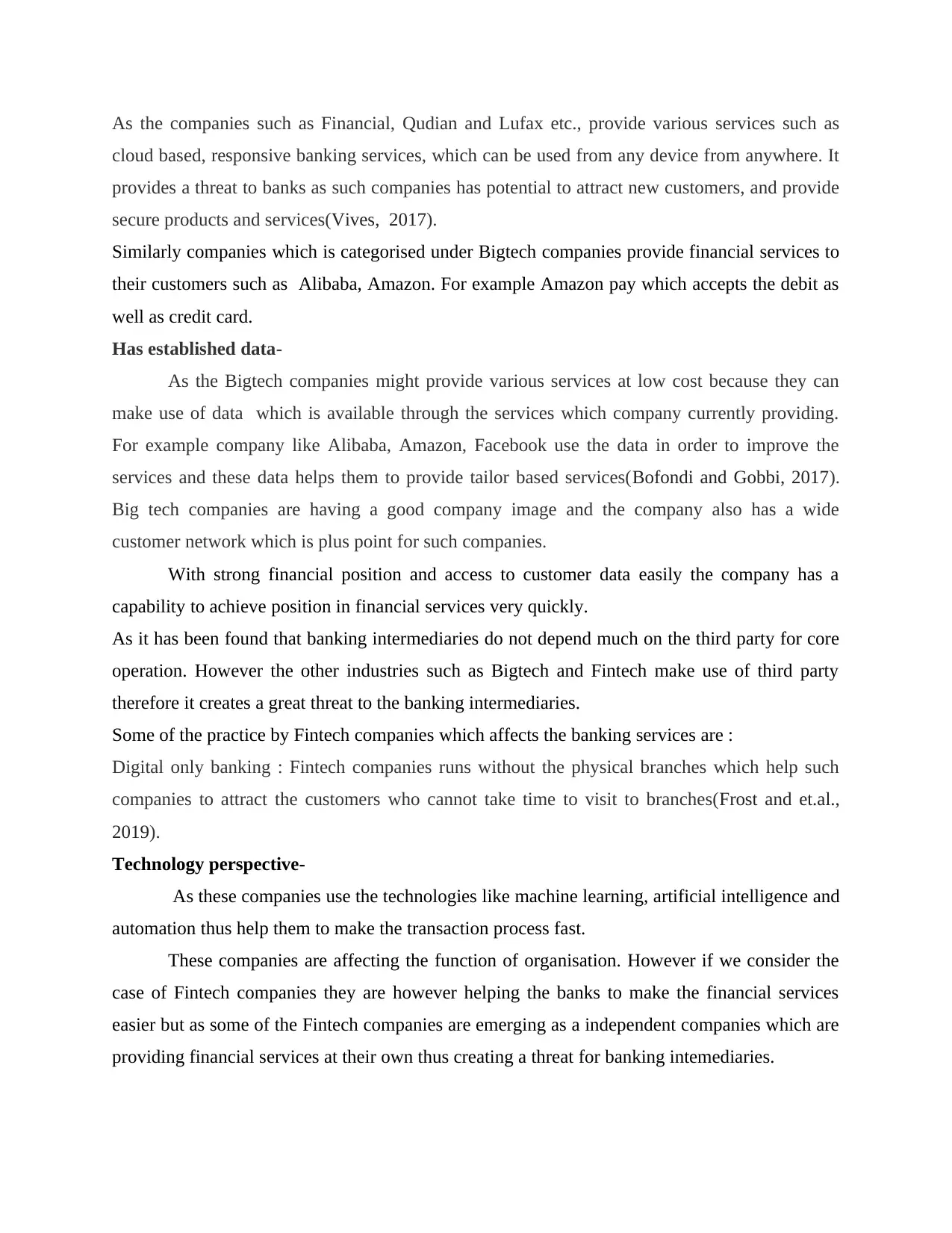
As the companies such as Financial, Qudian and Lufax etc., provide various services such as
cloud based, responsive banking services, which can be used from any device from anywhere. It
provides a threat to banks as such companies has potential to attract new customers, and provide
secure products and services(Vives, 2017).
Similarly companies which is categorised under Bigtech companies provide financial services to
their customers such as Alibaba, Amazon. For example Amazon pay which accepts the debit as
well as credit card.
Has established data-
As the Bigtech companies might provide various services at low cost because they can
make use of data which is available through the services which company currently providing.
For example company like Alibaba, Amazon, Facebook use the data in order to improve the
services and these data helps them to provide tailor based services(Bofondi and Gobbi, 2017).
Big tech companies are having a good company image and the company also has a wide
customer network which is plus point for such companies.
With strong financial position and access to customer data easily the company has a
capability to achieve position in financial services very quickly.
As it has been found that banking intermediaries do not depend much on the third party for core
operation. However the other industries such as Bigtech and Fintech make use of third party
therefore it creates a great threat to the banking intermediaries.
Some of the practice by Fintech companies which affects the banking services are :
Digital only banking : Fintech companies runs without the physical branches which help such
companies to attract the customers who cannot take time to visit to branches(Frost and et.al.,
2019).
Technology perspective-
As these companies use the technologies like machine learning, artificial intelligence and
automation thus help them to make the transaction process fast.
These companies are affecting the function of organisation. However if we consider the
case of Fintech companies they are however helping the banks to make the financial services
easier but as some of the Fintech companies are emerging as a independent companies which are
providing financial services at their own thus creating a threat for banking intemediaries.
cloud based, responsive banking services, which can be used from any device from anywhere. It
provides a threat to banks as such companies has potential to attract new customers, and provide
secure products and services(Vives, 2017).
Similarly companies which is categorised under Bigtech companies provide financial services to
their customers such as Alibaba, Amazon. For example Amazon pay which accepts the debit as
well as credit card.
Has established data-
As the Bigtech companies might provide various services at low cost because they can
make use of data which is available through the services which company currently providing.
For example company like Alibaba, Amazon, Facebook use the data in order to improve the
services and these data helps them to provide tailor based services(Bofondi and Gobbi, 2017).
Big tech companies are having a good company image and the company also has a wide
customer network which is plus point for such companies.
With strong financial position and access to customer data easily the company has a
capability to achieve position in financial services very quickly.
As it has been found that banking intermediaries do not depend much on the third party for core
operation. However the other industries such as Bigtech and Fintech make use of third party
therefore it creates a great threat to the banking intermediaries.
Some of the practice by Fintech companies which affects the banking services are :
Digital only banking : Fintech companies runs without the physical branches which help such
companies to attract the customers who cannot take time to visit to branches(Frost and et.al.,
2019).
Technology perspective-
As these companies use the technologies like machine learning, artificial intelligence and
automation thus help them to make the transaction process fast.
These companies are affecting the function of organisation. However if we consider the
case of Fintech companies they are however helping the banks to make the financial services
easier but as some of the Fintech companies are emerging as a independent companies which are
providing financial services at their own thus creating a threat for banking intemediaries.
Paraphrase This Document
Need a fresh take? Get an instant paraphrase of this document with our AI Paraphraser
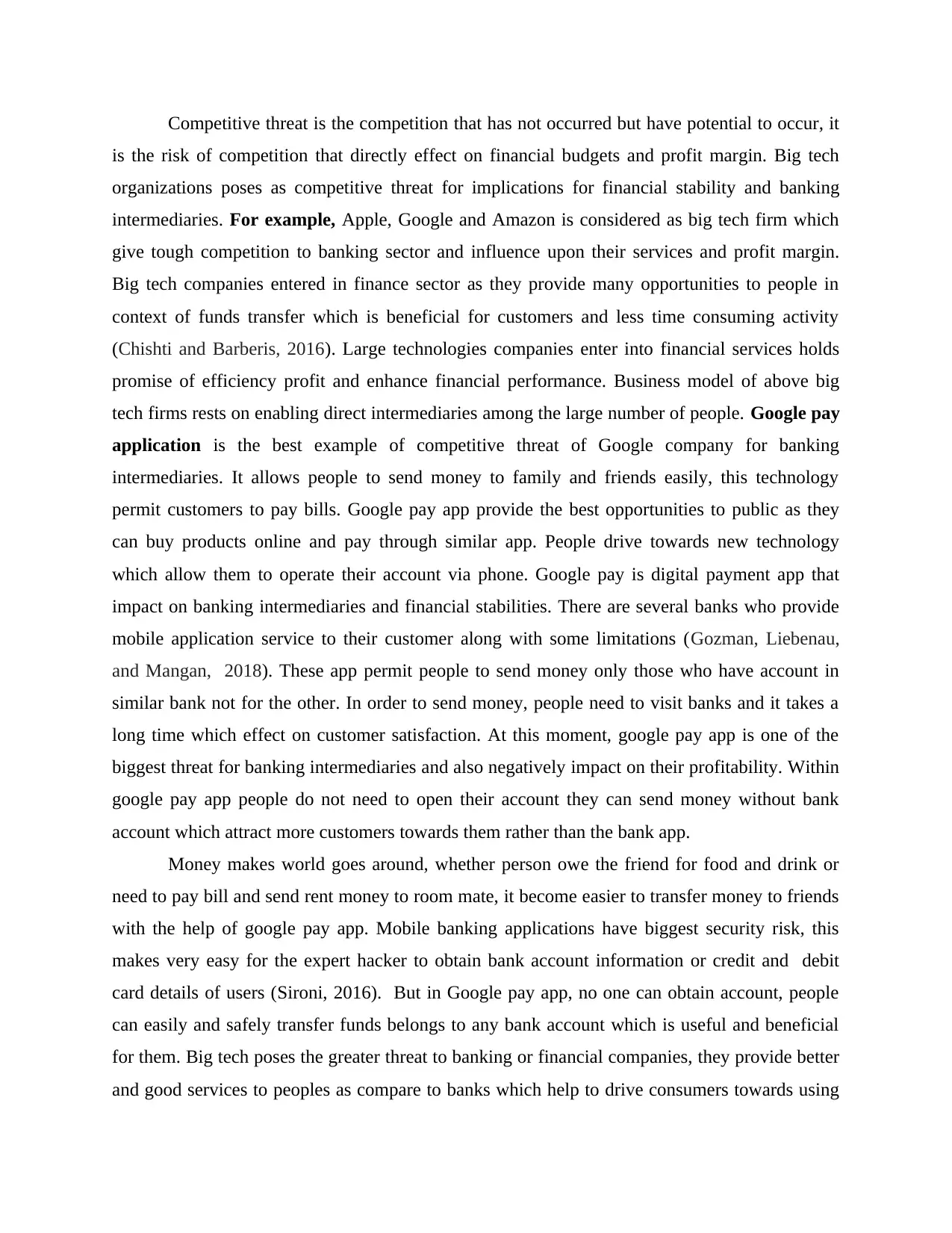
Competitive threat is the competition that has not occurred but have potential to occur, it
is the risk of competition that directly effect on financial budgets and profit margin. Big tech
organizations poses as competitive threat for implications for financial stability and banking
intermediaries. For example, Apple, Google and Amazon is considered as big tech firm which
give tough competition to banking sector and influence upon their services and profit margin.
Big tech companies entered in finance sector as they provide many opportunities to people in
context of funds transfer which is beneficial for customers and less time consuming activity
(Chishti and Barberis, 2016). Large technologies companies enter into financial services holds
promise of efficiency profit and enhance financial performance. Business model of above big
tech firms rests on enabling direct intermediaries among the large number of people. Google pay
application is the best example of competitive threat of Google company for banking
intermediaries. It allows people to send money to family and friends easily, this technology
permit customers to pay bills. Google pay app provide the best opportunities to public as they
can buy products online and pay through similar app. People drive towards new technology
which allow them to operate their account via phone. Google pay is digital payment app that
impact on banking intermediaries and financial stabilities. There are several banks who provide
mobile application service to their customer along with some limitations (Gozman, Liebenau,
and Mangan, 2018). These app permit people to send money only those who have account in
similar bank not for the other. In order to send money, people need to visit banks and it takes a
long time which effect on customer satisfaction. At this moment, google pay app is one of the
biggest threat for banking intermediaries and also negatively impact on their profitability. Within
google pay app people do not need to open their account they can send money without bank
account which attract more customers towards them rather than the bank app.
Money makes world goes around, whether person owe the friend for food and drink or
need to pay bill and send rent money to room mate, it become easier to transfer money to friends
with the help of google pay app. Mobile banking applications have biggest security risk, this
makes very easy for the expert hacker to obtain bank account information or credit and debit
card details of users (Sironi, 2016). But in Google pay app, no one can obtain account, people
can easily and safely transfer funds belongs to any bank account which is useful and beneficial
for them. Big tech poses the greater threat to banking or financial companies, they provide better
and good services to peoples as compare to banks which help to drive consumers towards using
is the risk of competition that directly effect on financial budgets and profit margin. Big tech
organizations poses as competitive threat for implications for financial stability and banking
intermediaries. For example, Apple, Google and Amazon is considered as big tech firm which
give tough competition to banking sector and influence upon their services and profit margin.
Big tech companies entered in finance sector as they provide many opportunities to people in
context of funds transfer which is beneficial for customers and less time consuming activity
(Chishti and Barberis, 2016). Large technologies companies enter into financial services holds
promise of efficiency profit and enhance financial performance. Business model of above big
tech firms rests on enabling direct intermediaries among the large number of people. Google pay
application is the best example of competitive threat of Google company for banking
intermediaries. It allows people to send money to family and friends easily, this technology
permit customers to pay bills. Google pay app provide the best opportunities to public as they
can buy products online and pay through similar app. People drive towards new technology
which allow them to operate their account via phone. Google pay is digital payment app that
impact on banking intermediaries and financial stabilities. There are several banks who provide
mobile application service to their customer along with some limitations (Gozman, Liebenau,
and Mangan, 2018). These app permit people to send money only those who have account in
similar bank not for the other. In order to send money, people need to visit banks and it takes a
long time which effect on customer satisfaction. At this moment, google pay app is one of the
biggest threat for banking intermediaries and also negatively impact on their profitability. Within
google pay app people do not need to open their account they can send money without bank
account which attract more customers towards them rather than the bank app.
Money makes world goes around, whether person owe the friend for food and drink or
need to pay bill and send rent money to room mate, it become easier to transfer money to friends
with the help of google pay app. Mobile banking applications have biggest security risk, this
makes very easy for the expert hacker to obtain bank account information or credit and debit
card details of users (Sironi, 2016). But in Google pay app, no one can obtain account, people
can easily and safely transfer funds belongs to any bank account which is useful and beneficial
for them. Big tech poses the greater threat to banking or financial companies, they provide better
and good services to peoples as compare to banks which help to drive consumers towards using
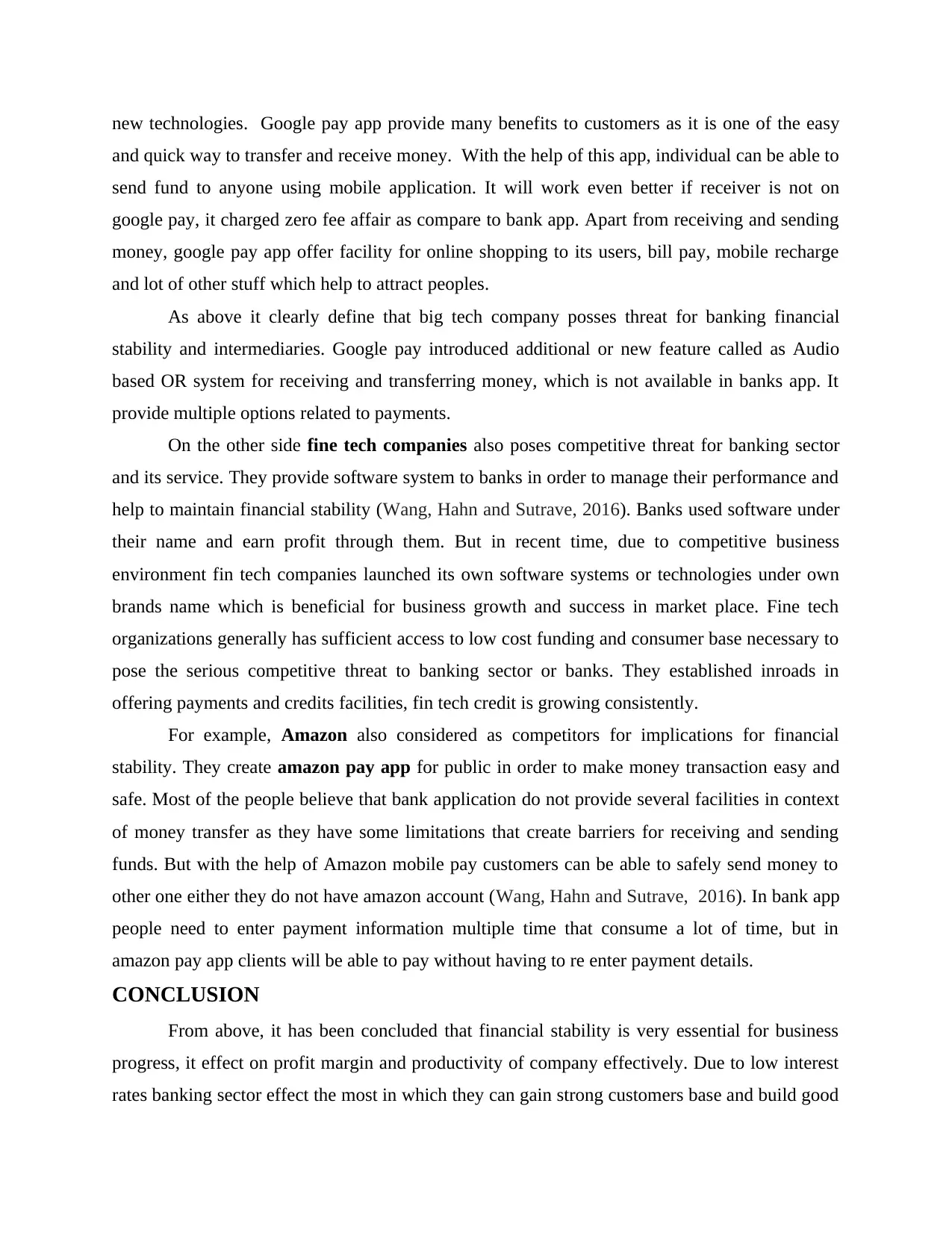
new technologies. Google pay app provide many benefits to customers as it is one of the easy
and quick way to transfer and receive money. With the help of this app, individual can be able to
send fund to anyone using mobile application. It will work even better if receiver is not on
google pay, it charged zero fee affair as compare to bank app. Apart from receiving and sending
money, google pay app offer facility for online shopping to its users, bill pay, mobile recharge
and lot of other stuff which help to attract peoples.
As above it clearly define that big tech company posses threat for banking financial
stability and intermediaries. Google pay introduced additional or new feature called as Audio
based OR system for receiving and transferring money, which is not available in banks app. It
provide multiple options related to payments.
On the other side fine tech companies also poses competitive threat for banking sector
and its service. They provide software system to banks in order to manage their performance and
help to maintain financial stability (Wang, Hahn and Sutrave, 2016). Banks used software under
their name and earn profit through them. But in recent time, due to competitive business
environment fin tech companies launched its own software systems or technologies under own
brands name which is beneficial for business growth and success in market place. Fine tech
organizations generally has sufficient access to low cost funding and consumer base necessary to
pose the serious competitive threat to banking sector or banks. They established inroads in
offering payments and credits facilities, fin tech credit is growing consistently.
For example, Amazon also considered as competitors for implications for financial
stability. They create amazon pay app for public in order to make money transaction easy and
safe. Most of the people believe that bank application do not provide several facilities in context
of money transfer as they have some limitations that create barriers for receiving and sending
funds. But with the help of Amazon mobile pay customers can be able to safely send money to
other one either they do not have amazon account (Wang, Hahn and Sutrave, 2016). In bank app
people need to enter payment information multiple time that consume a lot of time, but in
amazon pay app clients will be able to pay without having to re enter payment details.
CONCLUSION
From above, it has been concluded that financial stability is very essential for business
progress, it effect on profit margin and productivity of company effectively. Due to low interest
rates banking sector effect the most in which they can gain strong customers base and build good
and quick way to transfer and receive money. With the help of this app, individual can be able to
send fund to anyone using mobile application. It will work even better if receiver is not on
google pay, it charged zero fee affair as compare to bank app. Apart from receiving and sending
money, google pay app offer facility for online shopping to its users, bill pay, mobile recharge
and lot of other stuff which help to attract peoples.
As above it clearly define that big tech company posses threat for banking financial
stability and intermediaries. Google pay introduced additional or new feature called as Audio
based OR system for receiving and transferring money, which is not available in banks app. It
provide multiple options related to payments.
On the other side fine tech companies also poses competitive threat for banking sector
and its service. They provide software system to banks in order to manage their performance and
help to maintain financial stability (Wang, Hahn and Sutrave, 2016). Banks used software under
their name and earn profit through them. But in recent time, due to competitive business
environment fin tech companies launched its own software systems or technologies under own
brands name which is beneficial for business growth and success in market place. Fine tech
organizations generally has sufficient access to low cost funding and consumer base necessary to
pose the serious competitive threat to banking sector or banks. They established inroads in
offering payments and credits facilities, fin tech credit is growing consistently.
For example, Amazon also considered as competitors for implications for financial
stability. They create amazon pay app for public in order to make money transaction easy and
safe. Most of the people believe that bank application do not provide several facilities in context
of money transfer as they have some limitations that create barriers for receiving and sending
funds. But with the help of Amazon mobile pay customers can be able to safely send money to
other one either they do not have amazon account (Wang, Hahn and Sutrave, 2016). In bank app
people need to enter payment information multiple time that consume a lot of time, but in
amazon pay app clients will be able to pay without having to re enter payment details.
CONCLUSION
From above, it has been concluded that financial stability is very essential for business
progress, it effect on profit margin and productivity of company effectively. Due to low interest
rates banking sector effect the most in which they can gain strong customers base and build good
⊘ This is a preview!⊘
Do you want full access?
Subscribe today to unlock all pages.

Trusted by 1+ million students worldwide
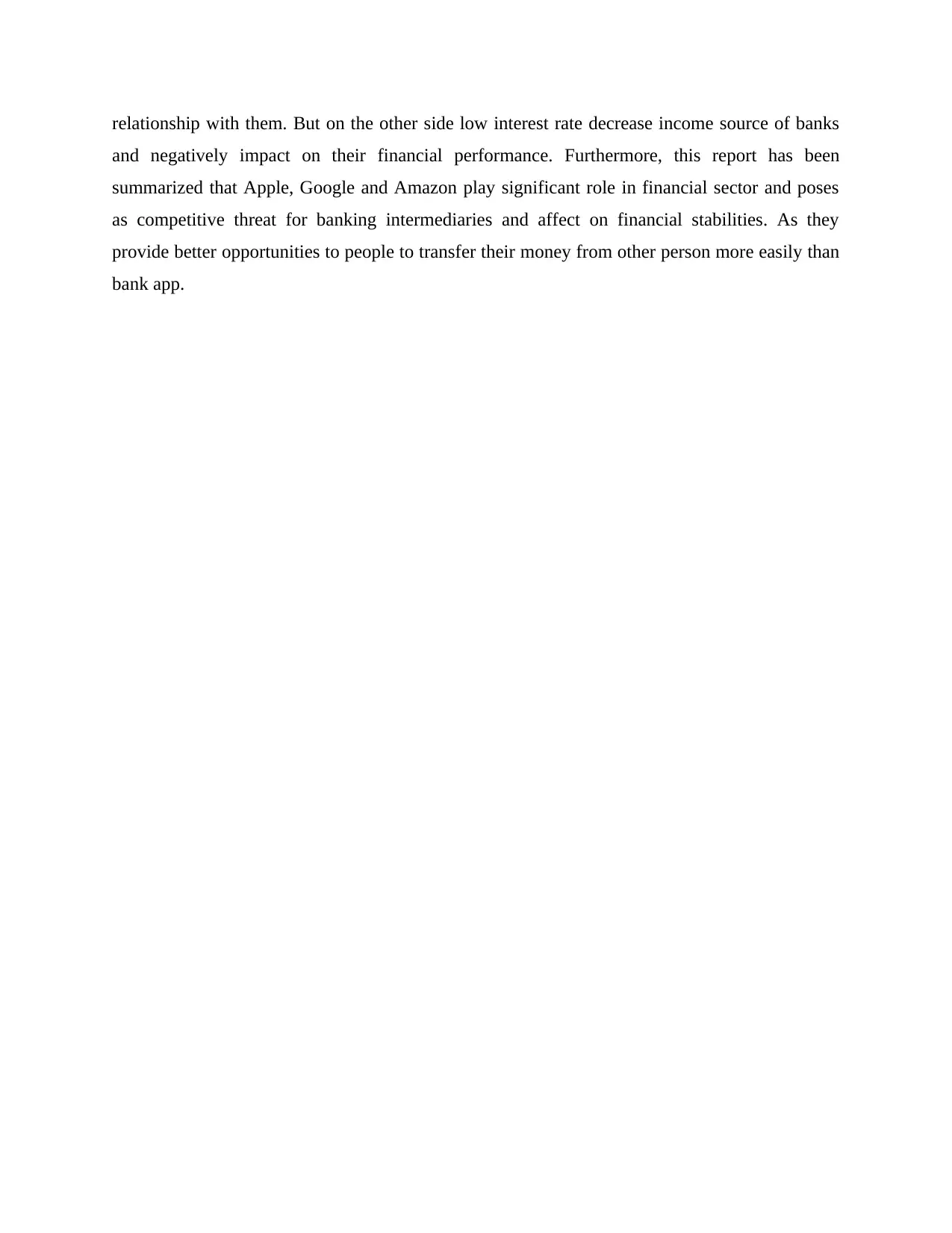
relationship with them. But on the other side low interest rate decrease income source of banks
and negatively impact on their financial performance. Furthermore, this report has been
summarized that Apple, Google and Amazon play significant role in financial sector and poses
as competitive threat for banking intermediaries and affect on financial stabilities. As they
provide better opportunities to people to transfer their money from other person more easily than
bank app.
and negatively impact on their financial performance. Furthermore, this report has been
summarized that Apple, Google and Amazon play significant role in financial sector and poses
as competitive threat for banking intermediaries and affect on financial stabilities. As they
provide better opportunities to people to transfer their money from other person more easily than
bank app.
Paraphrase This Document
Need a fresh take? Get an instant paraphrase of this document with our AI Paraphraser

REFERENCES
Book and Journals
Afonso, A., Baxa, J. and Slavík, M., 2018. Fiscal developments and financial stress: a threshold
VAR analysis. Empirical Economics. 54(2). pp.395-423.
Angelini, P. and et.al., 2015. B asel III: long‐term impact on economic performance and
fluctuations. The Manchester School. 83(2). pp.217-251.
Bofondi, M. and Gobbi, G., 2017. The big promise of FinTech. European economy, (2). pp.107-
119.
Chishti, S. and Barberis, J., 2016. The FinTech book: the financial technology handbook for
investors, entrepreneurs and visionaries. John Wiley & Sons.
Dagher, J., 2016. Benefits and costs of bank capital. International Monetary Fund.
Frost, J. and et.al., 2019. BigTech and the changing structure of financial intermediation.
Gozman, D., Liebenau, J. and Mangan, J., 2018. The innovation mechanisms of fintech start-ups:
insights from SWIFT’s innotribe competition. Journal of Management Information
Systems. 35(1). pp.145-179.
Jiménez, G. and et.al., 2014. Hazardous times for monetary policy: What do twenty‐three million
bank loans say about the effects of monetary policy on credit risk‐
taking?. Econometrica. 82(2). pp.463-505.
Joyce, M. and Spaltro, M., 2014. Quantitative easing and bank lending: a panel data approach.
Miyajima, K., Mohanty, M.S. and Chan, T., 2015. Emerging market local currency bonds:
diversification and stability. Emerging Markets Review. 22. pp.126-139.
Sironi, P., 2016. FinTech innovation: from robo-advisors to goal based investing and
gamification. John Wiley & Sons.
Smets, F., 2014. Financial stability and monetary policy: How closely interlinked?. International
Journal of Central Banking. 10(2). pp.263-300.
Vives, X., 2017. The impact of FinTech on banking. European Economy, (2). pp.97-105.
Wang, Y., Hahn, C. and Sutrave, K., 2016, February. Mobile payment security, threats, and
challenges. In 2016 second international conference on mobile and secure services
(MobiSecServ) (pp. 1-5). IEEE.
Williams, J.C., 2016. Monetary policy in a low R-star world. FRBSF Economic Letter. 23. pp.1-
23.
Online
Big tech in finance: opportunities. 2019. [Online]. Available
through:<https://www.bis.org/publ/arpdf/ar2019e3.htm>
BigTech Poses A Greater Threat To Financial Institutions. 2018. [Online]. Available
through:<https://www.forbes.com/sites/mayrarodriguezvalladares/2019/02/14/bigtech-
poses-a-greater-threat-to-financial-institutions-than-fintech/#3efda1be6a6a>
Sound Practices: Implications of fintech developments for banks and bank supervisors.2017.
[Online]. Available through:<https://www.bis.org/bcbs/publ/d415.pdf>
Book and Journals
Afonso, A., Baxa, J. and Slavík, M., 2018. Fiscal developments and financial stress: a threshold
VAR analysis. Empirical Economics. 54(2). pp.395-423.
Angelini, P. and et.al., 2015. B asel III: long‐term impact on economic performance and
fluctuations. The Manchester School. 83(2). pp.217-251.
Bofondi, M. and Gobbi, G., 2017. The big promise of FinTech. European economy, (2). pp.107-
119.
Chishti, S. and Barberis, J., 2016. The FinTech book: the financial technology handbook for
investors, entrepreneurs and visionaries. John Wiley & Sons.
Dagher, J., 2016. Benefits and costs of bank capital. International Monetary Fund.
Frost, J. and et.al., 2019. BigTech and the changing structure of financial intermediation.
Gozman, D., Liebenau, J. and Mangan, J., 2018. The innovation mechanisms of fintech start-ups:
insights from SWIFT’s innotribe competition. Journal of Management Information
Systems. 35(1). pp.145-179.
Jiménez, G. and et.al., 2014. Hazardous times for monetary policy: What do twenty‐three million
bank loans say about the effects of monetary policy on credit risk‐
taking?. Econometrica. 82(2). pp.463-505.
Joyce, M. and Spaltro, M., 2014. Quantitative easing and bank lending: a panel data approach.
Miyajima, K., Mohanty, M.S. and Chan, T., 2015. Emerging market local currency bonds:
diversification and stability. Emerging Markets Review. 22. pp.126-139.
Sironi, P., 2016. FinTech innovation: from robo-advisors to goal based investing and
gamification. John Wiley & Sons.
Smets, F., 2014. Financial stability and monetary policy: How closely interlinked?. International
Journal of Central Banking. 10(2). pp.263-300.
Vives, X., 2017. The impact of FinTech on banking. European Economy, (2). pp.97-105.
Wang, Y., Hahn, C. and Sutrave, K., 2016, February. Mobile payment security, threats, and
challenges. In 2016 second international conference on mobile and secure services
(MobiSecServ) (pp. 1-5). IEEE.
Williams, J.C., 2016. Monetary policy in a low R-star world. FRBSF Economic Letter. 23. pp.1-
23.
Online
Big tech in finance: opportunities. 2019. [Online]. Available
through:<https://www.bis.org/publ/arpdf/ar2019e3.htm>
BigTech Poses A Greater Threat To Financial Institutions. 2018. [Online]. Available
through:<https://www.forbes.com/sites/mayrarodriguezvalladares/2019/02/14/bigtech-
poses-a-greater-threat-to-financial-institutions-than-fintech/#3efda1be6a6a>
Sound Practices: Implications of fintech developments for banks and bank supervisors.2017.
[Online]. Available through:<https://www.bis.org/bcbs/publ/d415.pdf>
1 out of 11
Related Documents
Your All-in-One AI-Powered Toolkit for Academic Success.
+13062052269
info@desklib.com
Available 24*7 on WhatsApp / Email
![[object Object]](/_next/static/media/star-bottom.7253800d.svg)
Unlock your academic potential
Copyright © 2020–2025 A2Z Services. All Rights Reserved. Developed and managed by ZUCOL.





